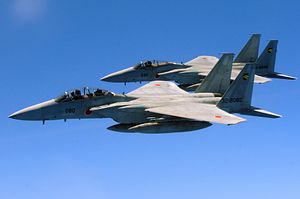The Japan Air Self-Defense Force (JASDF) scrambled its fighter jets 101 times in response to People’s Liberation Army Air Force (PLAAF) aircraft from April to June this year, down from 199 in 2016 during the same period last year, according to date released by the Japanese Ministry of Defense (MoD) on July 14. It is unclear what caused the drop.
Yet, while the overall number of intercepts declined by 52 to 229 in total from April to June 2017, the JASDF had to scramble its fighter jets a record 125 times in response to Russian military aircraft over the same period, or 47 times more often than in 2016. According to the MoD, Russian military reconnaissance aircraft were responsible for the bulk of increase, likely fueled by tensions on the Korean Peninsula and the presence of U.S. Navy carrier strike groups in the region.
However, Russia has also resumed its Cold War era strategic bomber patrols inside the Japan-Hawaii-Guam triangle. In April, the JASDF had to scramble fighter jets to intercept two Tupolev Tu-95MS strategic bombers and one Ilyushin Il-20 maritime reconnaissance and anti-submarine warfare aircraft flying down Japan’s east coast along the perimeter of Japanese airspace over the Pacific Ocean passing Hokkaido and Honshu until performing a U-turn at an offshore area near Tokyo. The aircraft came as close as 57 kilometers from Japan.
Last year saw a marked increase in PLAAF intercepts. JASDF had to launch its fighter jets a record 851 times in response to Chinese military aircraft. The East China Sea, around a group of uninhabited islands known in Japan as the Senkakus and in China as the Diaoyus and claimed by both countries, saw a particular uptick in Chinese activity. In response, the JASDF stood up a new air wing consisting of 40 Mitsubishi F-15J all-weather air superiority fighters at Naha Air Base, Okinawa in 2016.
Furthermore, the JASDF doubled the number of fighter jets dispatched to intercept foreign military aircraft approaching Japanese airspace from two to four in 2016 putting additional pressure on an already overstretched Japanese air force. The JASDF’s workhorse for intercepts is the F-15J fighter jet, 215 of which (including the upgraded F-15DJ/F-15J Kai variants) are currently in service. The JASDF is in need of at least 140 new fifth-generation fighter jets to be able to continue to protect Japanese airspace.
JASDF scrambled its fighter jets 1,168 times in fiscal year 2016, 301 times in response to Russian military aircraft. Fiscal year 2015 saw 873 overall sorties, with 288 in reaction to Russian military aircraft. During fiscal year 2014, Japan scrambled fighter jets 943 times, a record 473 of which were due to incursions by the the Russian Aerospace Forces. Russia is in the process of standing up a new long-range heavy bomber division in Russia’s Far East consisting of several dozen Tu-95MS strategic missile bombers and Tu-22M3 long-range bombers.































